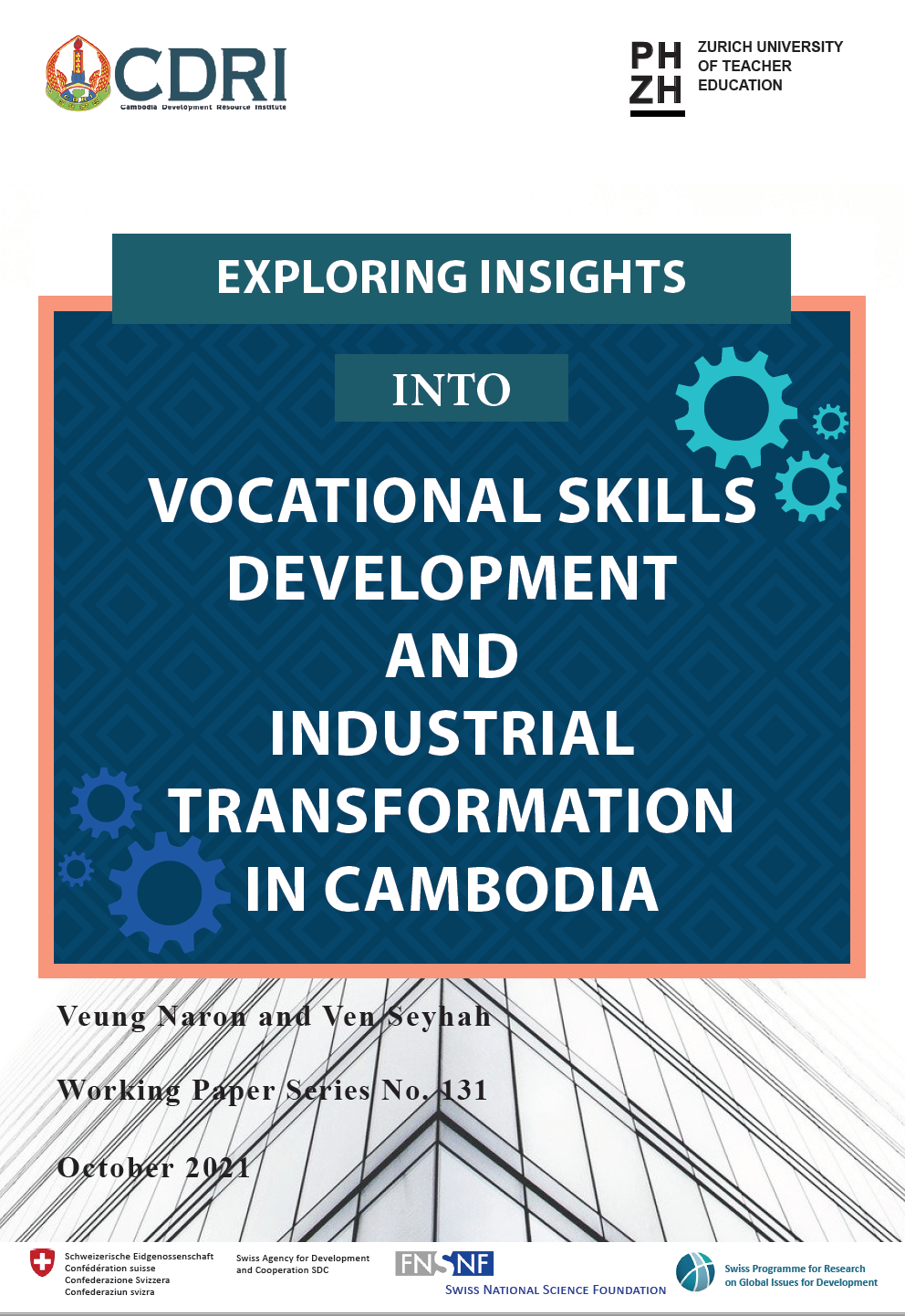
Exploring Insights into Vocational Skills Development and Industrial Transformation in Cambodia
Abstract/Summary
Industrial development is central to Cambodia’s economic development as it plans to upgrade the country’s status to an upper-middle-income country by 2030 and to a high-income country by 2050. Equipping the workforce with the skills and competencies that match industrial needs requires a great deal of continuous efforts and resources. In this regard, this paper aims to look into the linkage between skills and transformation based on employers’ perspectives. It explores insights into how companies perceive and use the skills and qualifications of their employees to overcome changes in technology, products and work organisation. These new insights will enable TVET providers, policymakers and other key stakeholders to develop a holistic skills development intervention that is responsive and relevant to the Cambodian labour market. This paper is based on the analysis of data from 36 qualitative interviews with managers and production heads or representatives from 18 companies in the electrical and electronic (E&E), garment and food processing sectors. Nvivo 12 software was employed for coding and thematic analysis of the employers’ perceptions of skills and qualifications in relation to job requirements, the relationship between skills and transformation, and human resource strategies to cope with the skills requirements posed by transformation.
General perceptions on skills and qualifications of the workforce
Most companies experienced skills shortage and recruitment difficulty when it came to high-and mid-level employees. The skilled labour shortage was worse for some companies located in the provinces, compared to those in the vicinity of Phnom Penh. The reported skilled shortage could be due to companies setting high recruitment requirements with specific skills and knowledge for higher positions, while applicants’ skills and knowledge were lower than those requirements. For low-skilled positions like general workers or operators, recruitment was usually easier as companies did not require them to have any specific TVET qualifications; also, those low-skilled employees could be trained in-house to operate machines manually. However, when a large number of those workers were needed by many companies at once, labour shortages also prevailed in some cases, especially in the provinces.
The quality and level of education and training were generally low among workers in the selected companies. Moreover, skills training programs were less relevant to the skills needs and requirements of most companies, and not many of those programs were available across the country. For instance, E&E and food processing companies found the available skills training programs unable to match their expectations and requirements in general. While struggling to get enough skilled labour, most companies agreed that having many employees with better education and training could help introduce new products, adapt to technological change and reorganise work systems. Because most companies lacked trust in the quality of education and training, they prioritised practical skills, knowledge and work experience for recruitment or promotion, while in-employment and internal training were widely valued and adopted as a main source of their employees’ upskilling and reskilling.
Transformation and its implications for skills
Major changes in technology, products and work organisation were reported in some companies in the selected sectors and these changes were driven by different internal and external factors, including market factors, increased product quality and quantity, skills and knowledge improvement, and labour and cost reduction. Particularly, those changes in the interviewed companies were believed to be intertwined with their employees’ skills, knowledge and experience. However, hiring high- and mid-level employees with the required skills did not have an impact on many companies changing their production machines or product types. Rather, these changes were introduced and facilitated by the expertise of their parent companies abroad, machine suppliers or main buyers. This might be because the skills, knowledge and experience of their high- and mid-level employees were lower than those of the technicians and experts from their parent companies or machine suppliers. It could also mean that the installation and maintenance of those machines required higher skills and experience, which were not available within the companies or the Cambodian labour market.
The enhanced skills and knowledge of employees were to some extent related to new technology, product types or work organisation introduced in companies. Changes in technology, product types or work arrangements required a certain change in employees’ skills and knowledge. Put simply, any employees involved in such changes had to adapt to those changes and improve their skills and knowledge accordingly over the course of those introduced changes. However, the interview data shows that only a few companies in the E&E, garment and food processing sectors clearly indicated an improvement in their employees’ skills and knowledge, and that, in the case of improvement, the additional skills or knowledge were acquired through peer learning.
As the changes were introduced, existing employees could also be affected physically or emotionally depending on the magnitude of the changes in terms of reduction in labour and costs for production improvements, employees’ increased skills and knowledge, increased workload and job responsibility, and management change. Most garment companies initiated an incentive platform or a reward system that was intriguingly motivational for all operators and employees. This bonus setup could enhance employees’ work performance, leading to productivity growth as well as employees’ upskilling and reskilling within many companies.
Strategies for overcoming skills challenges and problems
For dealing with the skills problems and challenges posed by transformation, companies used different strategies or methods, including outsourcing of technicians and experts, recruitment of new employees, internal promotion, and internal skills training and development. The outsourcing of technicians and experts was commonly found among many companies, as most companies were less likely to rely on their internal technicians, mechanics or engineers for the introduction of those changes, while also avoiding any recruitment of new employees or requirements for new, additional skillsets. Moreover, as the recruitment of new employees with skills and qualifications could be difficult and costly, most companies alternatively promoted their current employees based on work performance, practical skills and work experience in production. Internal promotion was widely used in all the sectors, and especially in the garment sector. Importantly, while internal training and development were heavily employed in all three sectors, formal training was scant and only happened in some large companies, for instance, in the E&E sector. High- and mid-level employees including managers, supervisors and some experienced team leaders who had strong foundational skills, knowledge and experience with production, and who had been with the companies for a long time, transferred their learned skills and knowledge to operators and general workers through peer learning, on-the-job training, work guidance, observation and practice.
Implications for policy consideration
Based on the employers’ perceptions of and experiences in skills and transformation, this study puts forward the following implications for policy consideration.
1. Promoting school-industry linkages through ensuring mutual benefits
Promoting school-industry linkages would help in bridging the skills gap between skills training programs and industrial skills requirements. Such collaborations should be sustained by ensuring mutual understanding and benefits between partners. The models of the Massachusetts Institute of Technology and the local Kirirom Institute of Technology exemplify a strong university-industry collaboration, allowing students to experience the best training programs and benefiting all the parties involved. The government should also initiate, coordinate and finance this collaboration model between TVET and respective industries to meet industrial skills demand. Furthermore, establishing TVET parks and/or training centres in industrial and special economic zones could help maximise the use of training facilities and company trainers through school-industry cooperation, while enhancing and expanding the training activities and services of the existing TVET parks and training centres would help reach out to more companies and beneficiaries. Therefore, cutting-edge technologies and facilities could be shared among companies and TVET schools offering practical skills training.
2. Increasing employment opportunities
Increasing employment opportunities could allow senior students and new graduates to learn from, adapt to, and experience real-work problems and workplace learning. This could be done through internships, apprenticeships and probation programs. Internships allow companies to observe whether students have the potential to be employees. An apprenticeship scheme should be mandatory across industries. In Germany, Switzerland, Austria, Hungary and South Korea, apprenticeships allow students to learn practical skills in the workplace, while participating in theoretical training at school. Such models are a win-win contract between schools, students and companies, but they need piloting or testing in Cambodia, where the current education and training system is different from those of the developed countries mentioned. Companies should also recruit employees with TVET skills and qualifications on a probation basis so that they can learn and adapt to the workplace.
3. Amplifying investments in generic and specific training
A certain number of supervisors and team leaders should be given more opportunities to have generic and specific skills training leading to certifications or qualifications. Moreover, companies should systematise their in-house training with appropriate and structured training content and levels, and keep records of the names of participants and training courses for further training or potential buyer requirements. Companies could issue certificates of attendance or participation. They should also work with relevant ministries, such as the Ministry of Labour and Vocational Training (MoLVT), and their development partners to develop a comprehensive skills certification/recognition system, allowing workers from industries to have their prior learning recognised. MoLVT and relevant line ministries also need to incentivise companies that have skills training to work in cooperation with TVET schools. Companies should develop an incentive or reward system that motivates workers to participate in skills training and to enhance work performance at all occupational levels. This incentive system should be a strategy to retain and promote employees to a certain level of management, while reducing unintended employee turnover and recruitment costs. Furthermore, equipping the existing and future workforce with fundamental technological skills and competencies is also an important task that companies and TVET schools need to do as Cambodia prepares to embrace the emerging fourth industrial revolution.



